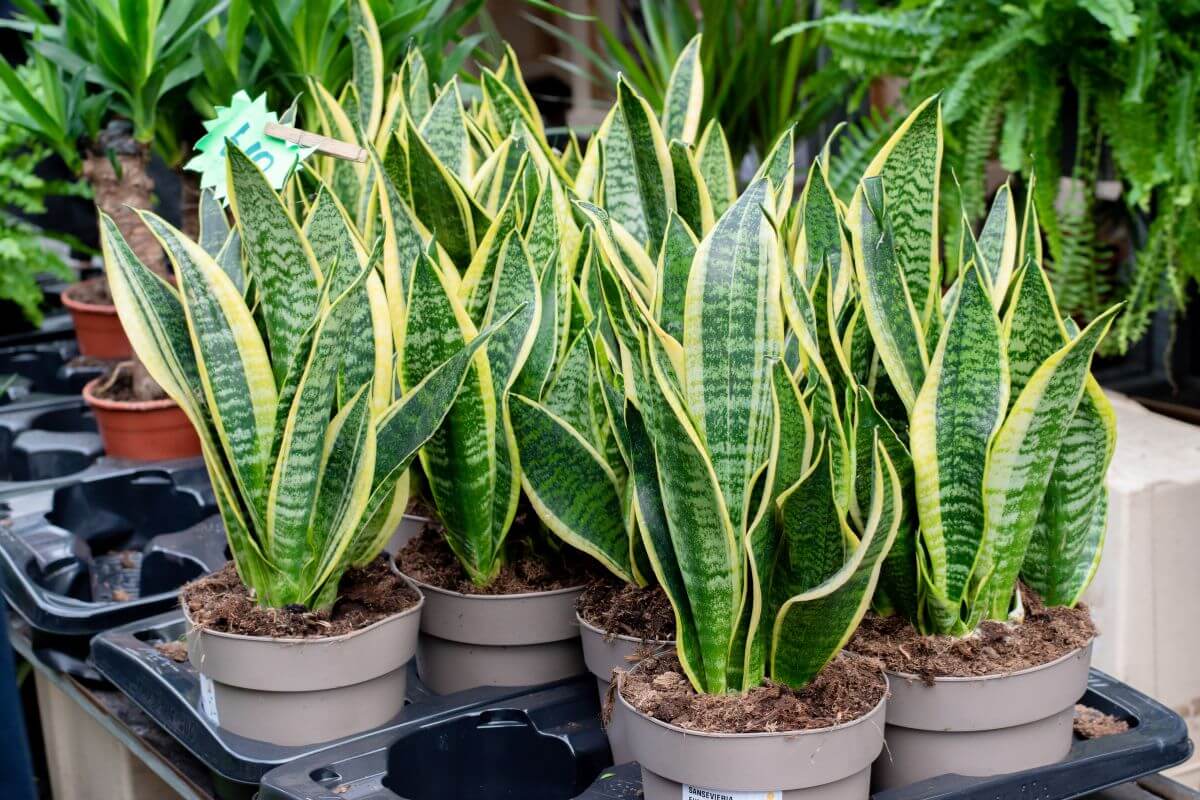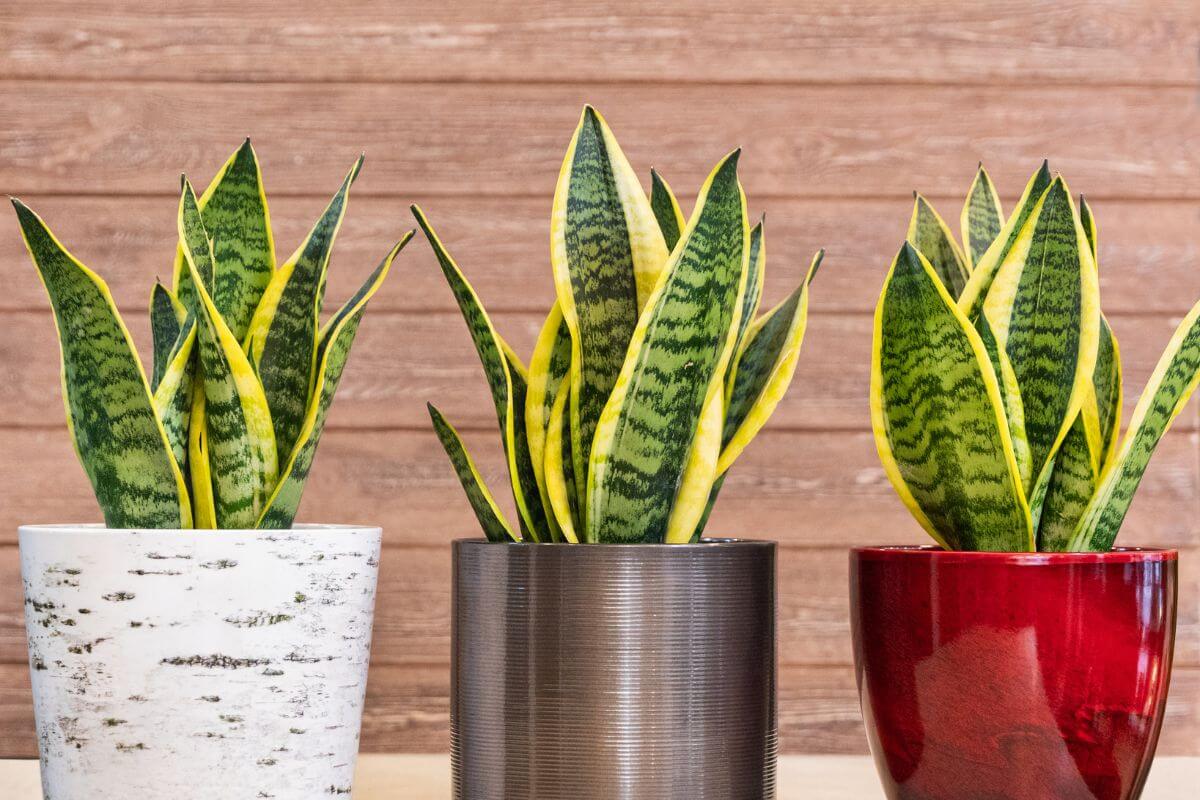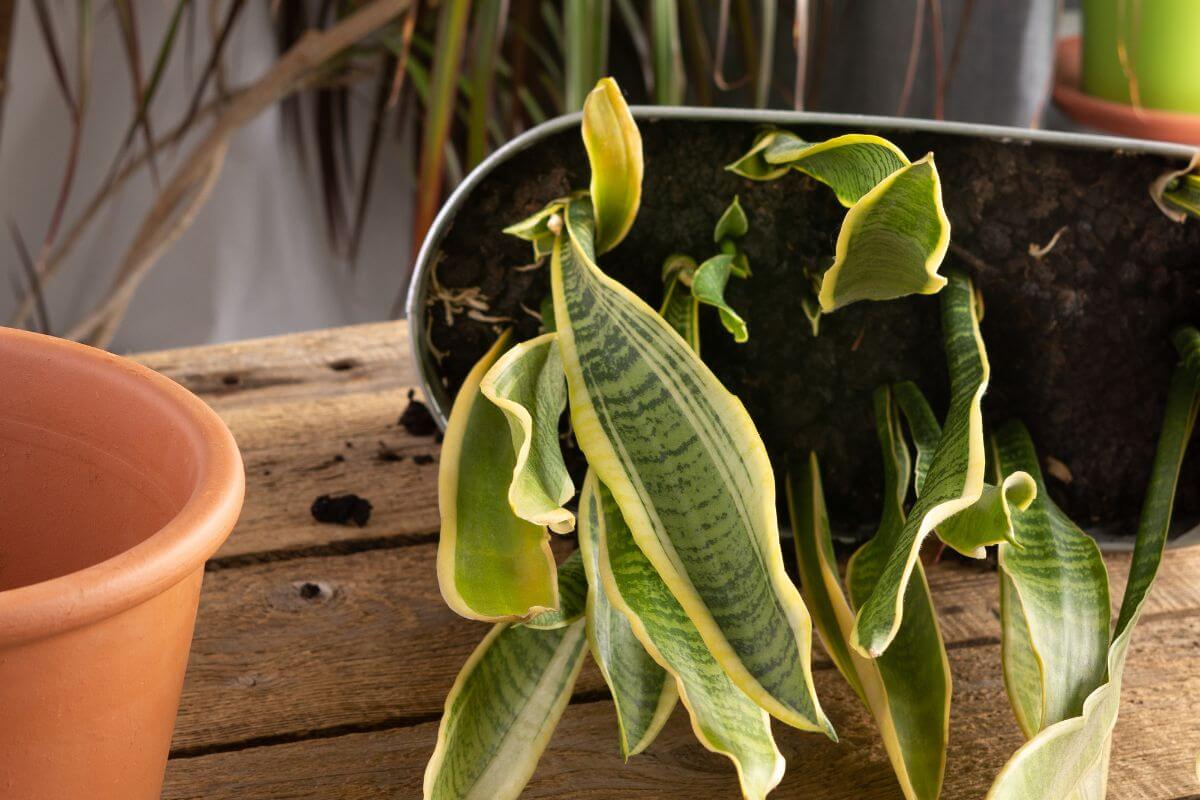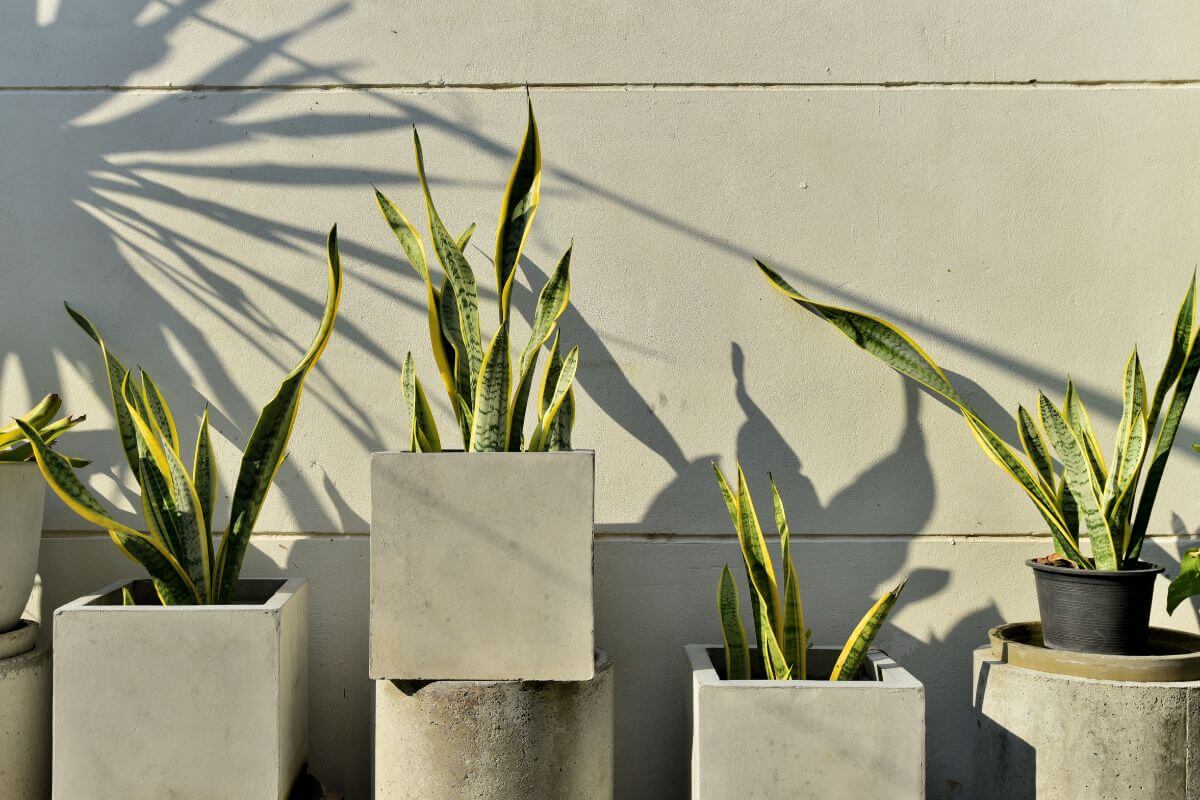The Snake Plant is one of the best houseplants to grow at home. This is especially true if you’re a beginner at home gardening and looking for an easy plant to take care of.
A snake plant also makes an excellent housewarming gift, an air purifier, and a lucky plant. Different types of snake plants exist to guarantee there’s one to fit any personality, as you will quickly learn below.
In this article, you will learn about how to grow a snake plant and how to take care of it. Keep reading to find out more about one of these great looking houseplants.
Snake Plant Overview

The snake plant, is a succulent native to West Africa, Nigeria stretching to the Congo, and Asia.
The Dracaena Trifasciata has many names often adapted from its appearance with dark green sword-shaped leaves that shoot upright. Some common names include: Sansevieria Trifasciata, Dracaena Trifasciata, Saint George’s Sword, Mother-in-Law’s Tongue, Viper’s Bowstring Hemp, as well as all the different species of snake plant.
Most people refer to it as a snake plant because of its upright position that resembles a snake ready to attack. It is called Saint George’s sword on account of the sword-shaped leaves. The Mother-in-Law’s Tongue name is based on the plant’s sharp edges that can pierce the insults from a mother-in-law. The viper’s bowstring hemp name is based on the plant’s strong fibers that people used to make bowstrings.
It used to be categorized in the Sansevieria genus, but in 2017 it changed to the Dracaena genus to much shock from the snake plant community. The second part of its name is Trifasciata, a Latin word that means “marked with three bands.”
There are over 70 variegated snake plant varieties with different colored streaks on the leaves like light green, white, silver, yellow, or dark green. The colorful markings explain why snake plants are also called Trifasciata. These are the most common varieties:
- Sansevieria Trifasciata – This is the most common species of the snake plant. It is usually identified through its tall, dark-green leaves and light gray-green stripes running left to right. The “Bantel’s Sensation” is an example of this species. It grows up to 3 feet long and has narrow leaves with white vertical stripes.
- Sansevieria Hahnii – It’s also known as the “Bird’s Nest” or “Golden Hahnii.” The Bird’s Nest has short, wide, dark, and light green leaves shaped like funnels. The leaves grow up to 8 inches long and need a lot of light to grow well. The Golden Hahnii looks the same, but with a yellow border on the edges of the leaves.
- Sansevieria Cylindrical – There are two versions: the “Cylindrical Snake Plant” and the “Starfish Snake Plant.” The former has cylindrical leaves that end in a sharp point. The Starfish has cylindrical leaves fanning out from the base, resulting in the starfish shape.
- Sansevieria Masoniana – The “Whale Fin” is a type of Sansevieria Masoniana usually characterized by the large, wide leaves that look like a whale’s fin above the water’s surface.
In West Africa, snake plants are believed to provide spiritual protection. They are used in rituals to ward off the evil eye, a dark stare that leaves a curse on each of its victims.
The Chinese believe the snake plant is associated with good luck. They believe that the gods bestow owners with eight virtues; long life, beauty, strength, intelligence, art, health, prosperity, and poetry.
Snake Plant Care Guide Overview

The snake plant is an easy-care houseplant to grow. These hardy snake plants can survive practically any conditions.
They’re generally slow-growing plants and can grow up to 12 feet tall outdoors, but indoors, it usually grows up to 4 feet tall.
When grown in optimal conditions and getting the nutrients, water, humidity, and light that they need, they’ll flower annually.
Soil for the Snake Plant
The key to your snake plant flourishing starts with losse, well-draining soil. Some gardeners use commercial potting soil, part pumice, builder’s sand, and coarse sand.
A popular choice is all-purpose cactus potting soil that can be found online.
Water and Humidity for the Snake Plant
It’s recommended that you water the snake plant every 2 to 3 weeks if it needs it. The plants store water in the leaves, so they require the soil to be moist, but soggy soil can lead to root rot. You’ll know there’s root rot if there’s a foul-smell.
Check if the soil is dry by dipping your finger into the soil. You should only water the plant when the soil gets completely dry.
They’re very hardy plants known to survive way past 3 weeks without water, but total neglect could lead to the death of the plant.
As a tropical plant, it likes humidity and doesn’t do well in dry conditions.
Light for the Snake Plant
A snake plant would do most light conditions in your home, including indoor light. They like medium to low light, but can also do well in bright light.
Place it by a window, but not exposed to direct sunlight as that will burn the leaves. Make sure it’s indirect light. Direct light will cause sunburn and cause the leaves to become thinner and lighter in color.
If kept in a corner with low light, the plant will still grow, albeit more slowly. Brighter light allows for a boost in growth. If there’s insufficient light, the leaves will start drooping.
The darker leaf types of snake plants like the Dracaena Trifasciata will tolerate low light, while the brighter leaf types will become dull and less patterned.
Temperature for the Snake Plant
Its native area is the tropics, so it prefers temperatures of 70°F to 85°F. Keep it away from cold and hot drafts.
If you have winters that go below 50°F, you’ll want to bring your plants indoors.
Fertilizing the Snake Plant
This type of plant rarely needs fertilizer, other than at the first stage of planting when it gets fresh soil. You could then fertilize it at a point during its growth, but it wouldn’t be necessary. A light layer of worm compost would be an adequate fertilizer.
Repotting the Snake Plant

Always ensure that your snake plant is repotted in fresh potting soil that drains well. The pot should have holes at the bottom, and be double the size of the last one.
Snake plants have rhizomes, a rooting system that spreads fast, so don’t be surprised if you see the roots bursting out of their pot with time.
It should remain in the same pot you bought it in 4 to 5 months before being repotted. After that, it could go 1 to 2 years before you would need to pot it again.
Propagating the Snake Plant
It is very easy to propagate a snake plant once you own one. Most people use plant cuttings that do well when propagated in either moist potting soil or water.
With leaf cuttings, make sure you always note which side was facing up to avoid planting the cutting upside down, leading to stunted/zero growth.
When propagating in water, change out the water every 3 days, and the cuttings will start producing roots in 6 to 8 weeks.
Common Problems Affecting Snake Plant
Most plant owners love the Dracaena Trifasciata because of the ease of maintenance. However, there are some things you should be on the lookout for.
Root Rot
The most common problem that affects snake plants is root rot, often resulting from overwatering. Root rot is indicated by black spots appearing on the leaves.
You can also check if you have mushy roots, which indicates rot. Remove the bad roots from the root ball and repot it with fresh soil.
They hate excess water because they already store water in the leaves. Too much will clog the stomata and lead to its death in under 2 weeks. You should only water the plant when it is completely dry, not just the topsoil, but the deeper layers too.
Pests
Usually, the thick cuticle of the plant means that it is difficult for any pests to bite into it, another reason to love the snake plant. Pests will attack the snake plant only when its under stress, usually from overwatering.
The most common pests that attack are mealybugs, which you can manage through rubbing alcohol wiped on the entire leaf or spraying neem oil on the leaves.
Dust
The leaves usually collect dust easily, so you need to wipe them down with a wet cloth. Otherwise, it clogs the stomata with time.
Burn Marks
This is usually a sign of over-fertilization. Direct sunlight burns leaves too.
Snake Plant Toxicity and Pets
Snake plants are poisonous to cats and dogs if chewed and ingested. If your pet eats the leaves, it has been known to cause vomiting, diarrhea, and even seizures. When chewed, it has a numbing effect that can cause the tongue and throat to swell.
So, if you notice anything unusual about your pet after eating these leaves, please seek medical attention immediately.
Snake Plant Care Tips

These are some tips to grow healthy snake plants:
- When buying a Trifasciata, knock off the pot to see the roots. You are looking for one with an intricate rooting system, a sign of good growth.
- Ensure you choose a plant with many new shoots emerging or the most compact looking plant.
- The plant likes to be root bound, so you should leave it in its pot for up to one year before re-potting.
Snake Plant Pros and Cons
There are several pros of owning a snake plant including: the low maintenance quality, its aesthetic appeal, a good luck symbol, and purifying the air.
The snake plant absorbs toxins and harmful chemicals from the air in your home such as, formaldehyde. At night, it emits oxygen and absorbs carbon dioxide, making it an excellent plant for bedroom decor.
It also promotes feng shui in the home depending on where you place it. For example, it shouldn’t be placed in a section with a lot of traffic or its energy will be disturbed.
You’ll love it for its elegant look that manages to make a room stand out regardless of where it is placed.
The only con to owning a snake plant is that it is a very common houseplant. You won’t have a unique houseplant that others won’t have.
Snake Plant Care Final Thoughts
The snake plant is a classic houseplant that many beginner gardeners have owned at one point or another. It can thrive in bathrooms, bedrooms, living rooms, and kitchens.
If you travel a lot, this is the ideal plant as it gives you greenery, while also being a low-maintenance plant.
Here are other houseplant guides that you’ll want to grow:
- Prayer Plant Complete Guide
- Schefflera Plant Complete Guide
- Spider Plant Complete Guide
- ZZ Plant Complete Guide
Snake Plant FAQs
Is the snake plant a good plant?
Yes! Snake plants are easy to care for. They add color to any indoor space. They’re great for beginners because they don’t require much water or fertilizer.
Do snake plants help you sleep?
Snake plants can help you sleep, because they also release oxygen at night. The extra oxygen can help people sleep better, so it’s a popular houseplant to place in bedrooms.
How tall do Dracaena Trifasciata Snake Plants grow?
The Dracaena Trifasciata, aka Snake Plant, can grow up to 12 feet tall when grown outdoors, and 4 feet high when grown indoors.
How much light do snake plants need?
Snake plants thrive with bright, indirect sunlight. The leaves will burn and fade when exposed to direct sunlight for extended bouts of time.
Is a snake plant toxic to cats and dogs?
Yes, snake plants are poisonous to cats and dogs when they bite into the leaf. The leaves are usually thick, which might deter the animal from trying. Symptoms of pets having ingested the plants include swollen tongues, nausea, and vomiting.
Can I mist my snake plant?
No, snake plants should not be misted at all. The plant prefers to remain dry. Misting may cause overwatering, which can lead to root rot.



